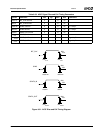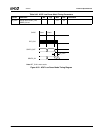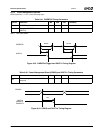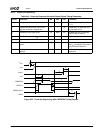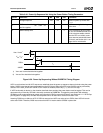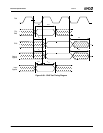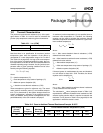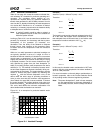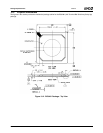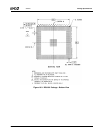
422 AMD Geode™ SC3200 Processor Data Book
Package Specifications
32581C
10.1.1 Heatsink Considerations
Table 10-2 on page 421 shows the maximum allowed ther-
mal resistance of a heatsink for particular operating envi-
ronments. The calculated values, defined as θ
CA
,
represent the required ability of a particular heatsink to
transfer heat generated by the SC3200 processor from its
case into the air, thereby maintaining the case temperature
at or below 85°C. Because θ
CA
is a measure of thermal
resistivity, it is inversely proportional to the heatsinks ability
to dissipate heat or its thermal conductivity.
Note: A “perfect” heatsink would be able to maintain a
case temperature equal to that of the ambient air
inside the system chassis.
Looking at Table 10-2, it can be seen that as ambient tem-
perature (T
A
) increases, θ
CA
decreases, and that as power
consumption of the processor (P) increases, θ
CA
decreases. Thus, the ability of the heatsink to dissipate
thermal energy must increase as the processor power
increases and as the temperature inside the enclosure
increases.
While θ
CA
is a useful parameter to calculate, heatsinks are
not typically specified in terms of a single θ
CA
.This is
because the thermal resistivity of a heatsink is not constant
across power or temperature. In fact, heatsinks become
slightly less efficient as the amount of heat they are trying
to dissipate increases. For this reason, heatsinks are typi-
cally specified by graphs that plot heat dissipation (in
watts) vs. mounting surface (case) temperature rise above
ambient (in °C). This method is necessary because ambi-
ent and case temperatures fluctuate constantly during nor-
mal operation of the system. The system designer must be
careful to choose the proper heatsink by matching the
required θ
CA
with the thermal dissipation curve of the
device under the entire range of operating conditions in
order to make sure that the maximum case temperature
(from Table 9-3 on page 352) is never exceeded. To choose
the proper heatsink, the system designer must make sure
that the calculated θ
CA
falls above the curve (shaded area).
The curve itself defines the minimum temperature rise
above ambient that the heatsink can maintain.
Figure 10-1 is an example of a particular heatsink under
consideration
Figure 10-1. Heatsink Example
Example 1
Assume P (max) = 5W and T
A
(max) = 40°C.
Therefore:
θ
CA
= 9
The heatsink must provide a thermal resistance below 9°C/
W. In this case, the heatsink under consideration is more
than adequate since at 5W worst case, it can limit the case
temperature rise above ambient to 40°C (θ
CA
=8).
Example 2
Assume P (max) = 9W and T
A
(max) = 40°C.
Therefore:
θ
CA
= 5
In this case, the heatsink under consideration is NOT ade-
quate to limit the case temperature rise above ambient to
45°C for a 9W processor.
For more information on thermal design considerations or
heatsink properties, refer to the Product Selection Guide
of any leading vendor of thermal engineering solutions.
Note: The power dissipations P used in these examples
are not representative of the power dissipation of
the SC3200 processor, which is always less than 4
Watts.
0
10
20
30
40
50
24 68
10
θ
CA = 45/9 = 5
Heat Dissipated - Watts
θ
CA = 45/5 = 9
Mounting Surface Temperature
Rise Above Ambient – °C
θ
CA
=
T
C
− T
A
P
θ
CA
=
85 − 40
5
θ
CA
=
T
C
− T
A
P
θ
CA
=
85 − 40
9



